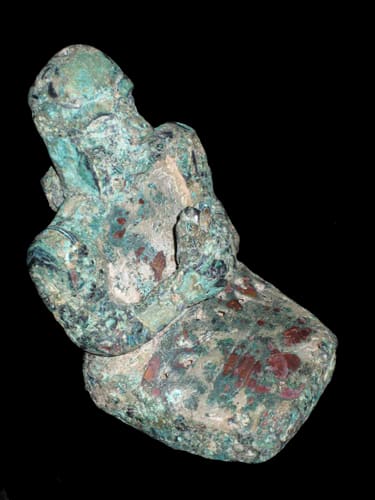Bronze Figure, 3300 BCE - 2500 BCE
Bronze
2.25 x 5
RP.009
This bronze sculpture of a praying figure was made in ancient Mesopotamia. Resembling gallery object number RP.004, it is somewhat larger, with a more monolithic presence. The body of the...
This bronze sculpture of a praying figure was made in ancient Mesopotamia. Resembling gallery object number RP.004, it is somewhat larger, with a more monolithic presence. The body of the piece is block-like, with an angular base, square shoulders and an inclined lap which is decorated with a band of geometric designs. The hands are gathered together on the lap, holding an as-yet unidentified object between them. The head is tall and austere, with well-marked brows and a long nose, framing empty eyes. The whole has an irregular patina with clear evidence of age.
Pieces such as this were made all over the area currently covered by Iraq, Iran and other Central Asian countries. Mesopotamia is also the birthplace of much that we currently recognise to be complex society, urbanisation and civilisation. Most areas were controlled by palace-temples that governed religious and social convention, with a resident aristocracy and various priests etc. These estates gathered taxation and ensured the economic and spiritual health of the serfs and freemen who worked for them. Pieces such as this were used to commemorate important members of the priestly class, and were treated as altar figures or personal talismanic items. This is a powerful piece of ancient sculpture.
Pieces such as this were made all over the area currently covered by Iraq, Iran and other Central Asian countries. Mesopotamia is also the birthplace of much that we currently recognise to be complex society, urbanisation and civilisation. Most areas were controlled by palace-temples that governed religious and social convention, with a resident aristocracy and various priests etc. These estates gathered taxation and ensured the economic and spiritual health of the serfs and freemen who worked for them. Pieces such as this were used to commemorate important members of the priestly class, and were treated as altar figures or personal talismanic items. This is a powerful piece of ancient sculpture.



